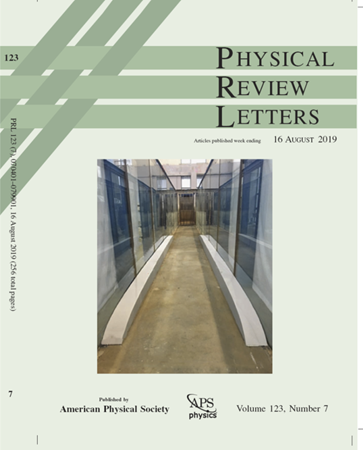Taming Spin Susceptibilities in Frustrated Quantum Magnets: Mean-Field Form and Approximate Nature of the Quantum-to-Classical Correspondence
IF 9
1区 物理与天体物理
Q1 PHYSICS, MULTIDISCIPLINARY
引用次数: 0
Abstract
In frustrated magnetism, the empirically found quantum-to-classical correspondence (QCC) matches the real-space static susceptibility pattern of a quantum spin-1/2 model with its classical counterpart computed at a certain elevated temperature. This puzzling relation was observed via bold line diagrammatic Monte Carlo simulations in dimensions two and three. The matching was within error bars and seemed valid down to the lowest accessible temperatures受挫量子磁体中自旋磁化率的驯服:量子-经典对应的平均场形式和近似性质
在受挫磁中,经验发现的量子-经典对应(QCC)与量子自旋1/2模型的实空间静态磁化率模式相匹配,并在一定的升高温度下计算其经典对应。这种令人费解的关系是通过在二维和三维的大胆线图蒙特卡罗模拟观察到的。匹配在误差条内,并且似乎有效,直到最低可达温度T比交换耦合J小一个数量级。在这里,我们使用恢复自旋图摄动理论解析地证明了QCC在J/T中的四阶弱破缺,并提供了经典温度和量子温度之间的近似映射。我们的处理进一步揭示了QCC是静态相关器可以通过简单的重整化平均场形式近似的惊人精度的指示。到目前为止,我们在QCC上下文中讨论的所有模型中都说明了这一点,包括最近的S=1材料K2Ni2(SO4)3的例子。平均场形式的成功可以追溯到部分图的消去。2025年由美国物理学会出版
本文章由计算机程序翻译,如有差异,请以英文原文为准。
求助全文
约1分钟内获得全文
求助全文
来源期刊

Physical review letters
物理-物理:综合
CiteScore
16.50
自引率
7.00%
发文量
2673
审稿时长
2.2 months
期刊介绍:
Physical review letters(PRL)covers the full range of applied, fundamental, and interdisciplinary physics research topics:
General physics, including statistical and quantum mechanics and quantum information
Gravitation, astrophysics, and cosmology
Elementary particles and fields
Nuclear physics
Atomic, molecular, and optical physics
Nonlinear dynamics, fluid dynamics, and classical optics
Plasma and beam physics
Condensed matter and materials physics
Polymers, soft matter, biological, climate and interdisciplinary physics, including networks
 求助内容:
求助内容: 应助结果提醒方式:
应助结果提醒方式:


